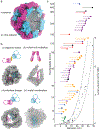Structure-based design of novel polyhedral protein nanomaterials
- PMID: 33784513
- PMCID: PMC8231309
- DOI: 10.1016/j.mib.2021.03.003
Structure-based design of novel polyhedral protein nanomaterials
Abstract
Organizing matter at the atomic scale is a central goal of nanotechnology. Bottom-up approaches, in which molecular building blocks are programmed to assemble via supramolecular interactions, are a proven and versatile route to new and useful nanomaterials. Although a wide variety of molecules have been used as building blocks, proteins have several intrinsic features that present unique opportunities for designing nanomaterials with sophisticated functions. There has been tremendous recent progress in designing proteins to fold and assemble to highly ordered structures. Here we review the leading approaches to the design of closed polyhedral protein assemblies, highlight the importance of considering the assembly process itself, and discuss various applications and future directions for the field. We emphasize throughout the exciting opportunities presented by recent advances as well as challenges that remain.
Copyright © 2021 Elsevier Ltd. All rights reserved.
Figures



References
-
- Pieters BJGE, van Eldijk MB, Nolte RJM, Mecinović J: Natural supramolecular protein assemblies. Chem Soc Rev 2016, 45:24–39. - PubMed
-
- Douglas T, Young M: Viruses: making friends with old foes. Science 2006, 312:873–875. - PubMed
-
- Norn CH, André I: Computational design of protein self-assembly. Curr Opin Struct Biol 2016, 39:39–45. - PubMed
Publication types
MeSH terms
Substances
Grants and funding
LinkOut - more resources
Full Text Sources
Other Literature Sources

